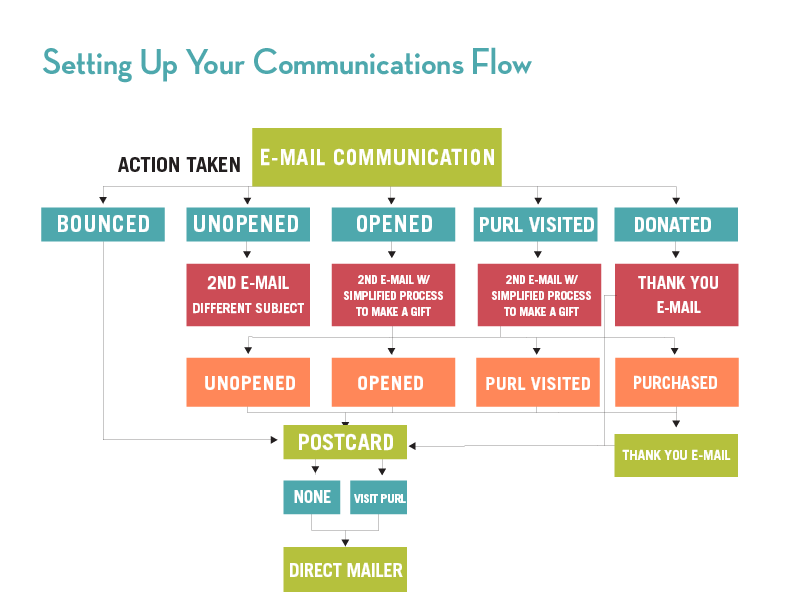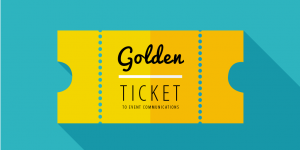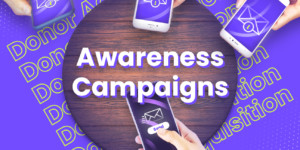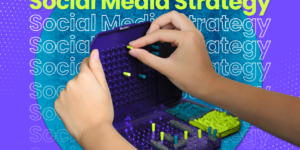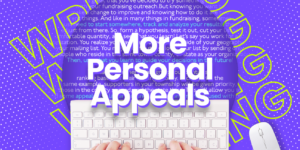September marks the beginning of the school year, and educational institutions are swarmed with incoming students and a host of new challenges. Each new class brings new pupils as well as their parents and family members. Why is that significant? Because for independent schools or higher ed, this presents an opportunity to begin cultivating these individuals as prospective donors. As many annual funds begin to launch, that back pocket plan we always talk about should be kept in mind. Pulling from 2015, this post outlines a simple multi-touch and integrated campaign that can take you through the end of the calendar year (otherwise known as the busy season).
Each day we’re bombarded with thousands of messages, some of which resonate and others simply breeze on by. Marketing communications can vary greatly from one shop to the next. Sometimes social posts, emails, and one-off mailers are piecemeal and sent without a strategy in mind. Other times what can look like a simple message, like an email offer, is really part of a bigger marketing campaign with many touches based on how we, as the recipient, engage from day one.
Where the magic happens is in crafting copy and designing creative that speaks to the target audience on a deeper level that also changes based on whether or not action is taken. Seems tricky, right? Well, in hopes of uncovering what happens behind the curtain, we’re going to dissect a basic 3-touch integrated campaign. A better understanding of this process will allow for more adequate planning and improve your ability to connect with your constituents in a more meaningful way. Note that this overview is for beginners, and more advanced strategies (like versioning by donation history and gift amount) will be discussed at another time.
Campaign Preparation and Initial Email
For the sake of this exercise, let’s say that we’re trying to raise money to run an afterschool program for inner city youth. The first step is determining what action you want the end-user to take. In this case, the call to action will be to donate. Recipients will be encouraged to donate by the narrative you as the sender will create. Your story starts with why. Going beyond the recitation of your mission statement, address in a compelling way why you exist to do the work you do. Establish mutual values with your audience in order to have your message resonate on an emotional level. Then you can discuss what is being offered (activities), who will benefit and how (populations served and goals/outcomes), and how the money will be used (e.g. supplies, teachers, transportation). Remember, this story is going to be told throughout the entire campaign so be prepared to illustrate this in a few ways. But now you have your plan, so gather a handful of relevant photos and videos (if available), and make sure the overall design (for email and print) is eye-catching and consistent across all communications.
You should also be prepared to receive donations online and by mail. Make sure you’ve got a donation page set up on your organization’s website. For added benefit, create a unique landing page for the event or even create a custom personalized URL (pURL) for each individual. Utilizing pURLS allows you to track engagement more accurately and attribute page views down to specific individuals. More and more people are giving online, so it’s important that your page is also mobile-friendly and responsive. The objective is to make the process of making a donation as easy and seamless as possible.
Now that you’ve got everything situated, it’s time to send your first email. Using the story you’ve crafted, you will make your first appeal to those in your database. Keep your copy focused, images prominent, and make sure your call to action (in this case a DONATE NOW button) is clear and properly linked. The key to running a successful campaign is looking at engagement and optimizing each subsequent touch based on actions taken previously.
The chart below helps to visualize the many steps of an integrated campaign. Note how the goal (donate now) remains top of mind, and how the focus remains on engagement. In the case of cultivating new audiences, this practice is especially useful because it helps fundraisers figure out what kinds of language, images, formats and stories work for specific subsets of your audience.
Following Up with a 2nd Email
Once your first email is sent, it’s time to start reviewing engagement. Most email marketing software provides a report of overall performance. Here’s what you’ll want to look for and the best next step:
Emails that bounced
A bounced email is one that could not be delivered. You’re going to want to communicate with these people by direct mail. Make sure their names are in your mailing database and set them aside.
Unopened emails
If the recipient didn’t open the email, chances are they missed the message or the subject line wasn’t engaging. For this group, you’ll resend the message with a different subject line.
The email was opened, but no action was taken
Isn’t this frustrating? You got them to open the door, but they really weren’t buying what you were selling. They didn’t donate, and they didn’t click any links. But like the old adage says: try, try again. What we do know is that they found something compelling enough to open the email, which means they could just need another nudge in the right direction. Resend the email with a more simplified process. Try rewriting copy to communicate with more of a sense of urgency, but keep that donate button front and center.
The email was opened and they clicked, but didn’t donate
Okay, maybe this is more frustrating than before. Nevertheless, do the same thing. Simplify and send again.
They donated!
Awesome! All you have to do now is send a thank you email. Make sure those that donate are suppressed from future communications from this campaign (excluding the thank you message). But keep in mind, just because they gave doesn’t mean the relationship is over. Find a creative way to further the story in your thank you message and begin the stewardship process. We’ve got some great tips for that here.
Consider Direct Mail
Hopefully you’re getting a feel for how this works. You should have a good sense of how to manage communications based on engagement, and where you need to tweak things in order to improve your end results. But what happens if your second email isn’t really performing too well? It’s time to consider another channel: direct mail. Here’s what to do:
If they still didn’t open the email or the opened but didn’t click or donate…
They’re getting something in the mail. Try to figure out what might not be working in your favor and change things up. A postcard might be your best option, since you don’t need to rely on the recipient opening an envelope to get the message. You want to keep things simple, so put your energy into the design. A large, unconventional size might just do the trick and get their attention. Make sure the donation pURL is big and clear.
They donated!
Good job! Send that thank you then suppress!
Last Call
There are only a few ways this is going to work out, but it’s important to have a plan for even this last and most unnerving round of communications:
If they didn’t donate or visit the website…
Before you decide to cut your losses, try one last time by mail. A straightforward personalized appeal letter could just do the trick.
If they visited the website, but didn’t donate…
Hey, they’re showing some kind of engagement. Maybe it’s time to throw on the charm, and a personal touch can go along way. Since they’re demonstrating some kind of interest, how about giving them a phone call? It’s not always easy to get someone on the horn and it certainly takes some time, but keep in mind: people generally want to give, they just need to be asked. So if you can get a hold of someone, tell them how much a donation would really make a difference and how valuable they would be as a partner. It couldn’t hurt.
The Wrap Up
There are so many strategies that can be applied to a communications campaign. But if you’re new to this kind of process, this is a great place to start. Be bold, be direct, and don’t be afraid to ask. In the beginning it’s important to keep things simple, especially if your audience isn’t used to hearing from you in this fashion. Use social media to draw attention to the campaign and give your story some extra power. Advanced tactics include deep personalization, multiple versions, and more channels… but we can get to that another time!
You Might Also Enjoy:
+ The 4 Principles of Visual Storytelling
+ From the Vault: There’s Always Room for a Story
+ 5 Ways to Put Your Donation Page to Work
Like what you see? Stay in touch!


